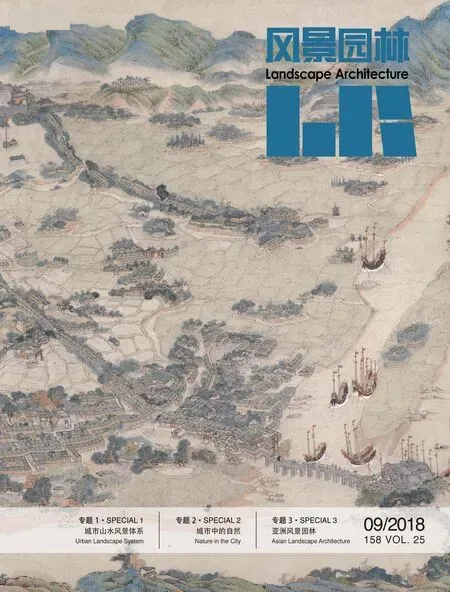班德尔玛奇想花园
(英)迈克尔·考迪
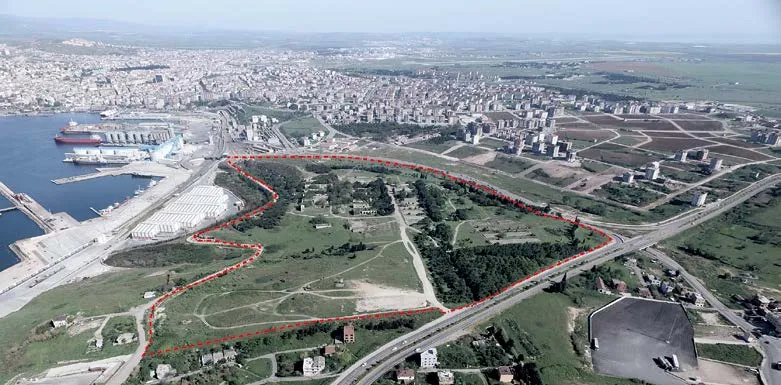
1 航拍照片,包括项目地点和班德尔玛市中心Aerial photograph including the project site and Bandirma city centre
概况
背景
班德尔玛(Bandirma)奇想花园旨在通过空间规划设计开发一种新型公园项目,同时在班德尔玛市内创建一个游憩场所。
班德尔玛坐落在土耳其最具活力的地区,计划通过新港口成为工业出口的主要门户区域。预计这一区域转型将推动班德尔玛市区的再生。
就这一点而言,该项目所在地通过区域未来的后工业转型,在城市密集的区块中提供了一个形成新型和多选择性公共开放空间的绝佳机会。
地区
班德尔玛区位于马尔马拉地区(Marmara Region),那里有土耳其最高的总人口、城市人口和人口密度。作为伊斯坦布尔(Istanbul)这一著名城市的老城,该地区吸引了南马尔马拉[Southern Marmara,布尔萨(Bursa)和巴勒克希尔(Balikesir)周边地区]和东马尔马拉[Eastern Marmara,科贾埃利—盖布泽(Kocaeli-Gebze)线]的人口、产业和发展机遇。
城市
班德尔玛是一个位于马尔马拉海南部的港口城市。城市的建立可追溯到公元8—9世纪,而今天的现代城市则在19世纪于城市西北的山坡上开始形成。当时的工业发展促进了城市沿主要道路向东南部地区蔓延。在接下来的几年中,该城市向西发展,项目所在地便在此处。
人口
就班德尔玛人口的增长而言,1980年和2010年是颇为重要的转折点。班德尔玛港口投入使用后,人口数量在1980—2000年间由5万增加到10万,然后在工业发展的推动下在21世纪的前十年继续上升达到15万。在过去的15年,该市的城市人口增长率为43%,此外还有2万的农村人口。
班德尔玛的居民有很高的教育水平。这座城市的识字率为99.5%。25%的居民是研究生, 30%的人受过中等教育。班德尔玛的人口结构和高城镇化率使其在教育领域发展迅速。预计城市将在未来几年吸引农村人口向城市转移。这就是2040年的环境计划项目预计城市人口将增加4倍,而农村人口将减少到16 500的原因,意味着城市化进程的加快。
产业
班德尔玛坐落在现在的伊斯坦布尔、布尔萨(Bursa)、伊兹密尔(Izmir)的腹地,通过航海线与伊斯坦布尔和泰基尔达(Tekirdag)连接,并通过高速公路与巴勒克希尔、伊兹密尔、恰纳卡莱(Canakkale)和布尔萨相连。因此,区域规划的战略重点是提高城市的可达性。考虑到工业发展面临的交通联系及其前景,新的设计更加强调了工业部门之间的联系,因此城市正在重新规划。
从这个观点来看,班德尔玛正在成为重要的城市之一,这些城市为邻近的伊斯坦布尔和巴勒克希尔等不堪重负的大都市提供支持。农业在班德尔玛的经济中扮演着重要的角色,特别是谷物,还包括烟草、棉花、甜菜、橄榄和葡萄,此外,蔬菜在该地区肥沃的耕地上广泛种植。渔业和水产品则是主要的谋生方式。而工业方面则以制造业为主导。
在迅速发展的驱动下,该地区演变成为工业、旅游和交通的中心。同时新的规划正在推进。
场地
场地特征
该项目位于巴勒克希尔大都市区的班德尔玛市,坐落在叶尼玛哈尔(Yenimahalle )社区和阿依尔德兹(Ayyıldız)社区之间。
项目场地位于区域西部边缘,面积约26hm2。位于市中心和港口的步行范围之内,被战略性地规划为靠近班德尔玛中心的一个大型开放公共场所。
除了与市中心和港口的紧密连接之外,项目场地的西部和西南部邻近是新的住房开发。通过港口路和埃尔代克路可以到达场地。该场地距离周边城市的72所大学也仅有2~3h的路程。
现在的城市中心与项目场地直接相关,是该地区最重要的商业和工业场所之一。班德尔玛繁忙的港口及其邻近的贸易中心是商业增长的最重要因素之一。
微气候
项目位于巴尔干半岛(Balkanic)大陆性气候过渡地区。根据62年的数据记载,班德尔玛最低温度为-14.6℃(1954年1月15日),最高温度为42.4℃(2000年7月9日),平均气温为14ºC。主导风向为东北偏北,平均风速为15km/h。该区平均降水量为7 033 kg/m,年相对湿度为73%。
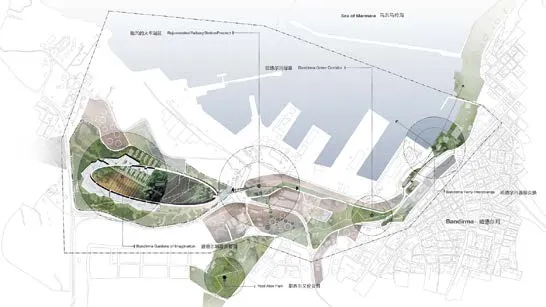
2 城市环境图Urban Context Diagram
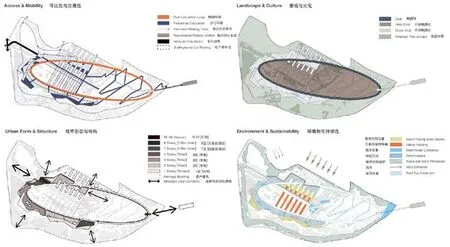
3 城市策略Urban Strategies
区域主导风向为北、东北偏北和西北偏北。冬季最高频风速为10km/h,占所有时期的4.8%,而夏季月份最高频风速为15km/h,占所有时期的2.6%。
历史遗产
多年来,这个场地一直是一个军事仓库。2000年初场地被遗弃,然而直到2016年年中土地才移交给市政府。
项目场地中包含了一些军事建筑物,这些建筑至今仍在现场。在自然遗产保护署的官方声明中:由于其艺术、建筑、历史、美学、地方特色、装饰、象征、文献、功能、金融、纪念、影响力、独特性、特色、材料、结构和样式特点等因素,这些建筑或废墟中的21个被列入二级“文化遗产保护”名录,并不允许立面上的改变。
景观
项目所在地主要覆盖有常绿矮灌丛、针叶树群和疏散灌木丛。常绿矮灌丛如多刺地榆(Sarcopoterium spinosum)、针刺矢车菊(Centaurea iberica)、鹰爪豆(Spartium junceum)、黄芪(Astragalus sp.)、麝香草(Coridothymus capitatus)等,可以在受海洋影响的一部分地区,如斜坡和北部边界找到;针叶树组成的树群,则如黎巴嫩雪松(Cedrus libani)、土耳其松(Pinus brutia)、意大利石松(Pinus pinea)、地中海丝柏(Cupressus sempervirens)等;此外悬铃木属的植物(Platanus sp.)、扁桃树(Amygdalus communis)、无花果树(Ficus carica)和桑树(Morus sp.)等阔叶树种也有零散分布。
项目场地以成熟的针叶树群(由雪松、松树和柏树组成)、混合树群(落叶和针叶树)以及小山上的常绿矮灌丛为主要特色。自然因素如风的影响会使得针叶树形成独特的形态。植物与历史遗迹一起,展现了场地独特的景观特征。在这方面,项目提案必须对现有的景观环境制定一个悉尼的设计手段。树群必须得到保护,项目必须清楚地反映整个场地的保护措施。
策略
策略陈述
班德尔玛奇想花园采取全面、多层次的方式,代表了一个尊重地区过去的标志性愿景,同时也展望了一个创造性的未来。通过经验的独特结合,班德尔玛奇想花园象征着班德尔玛的变革。
构思概念的生成原则,包括1)整合:与场地周边环境的完美衔接。2)组织:使用标志性形式来组织场地。3)并置:将现代与历史并置。4)界定:以建构形式界定开放空间。5)回应:用大胆的现代表层回应场地历史。6)连接:将场地融合于周围环境。7)标志:创建一个具有国家和国际影响力的地标。
可达性与交通性
连通性的改善对于班德尔玛奇想花园的成功至关重要。主要的交通举措包括从西部进入的公交和车辆、建筑物下方的地下停车场以及一座新建的绿色桥梁,使之与更新后的火车站无缝连接。这些举措构成了行人优先的环境基础。环境的核心是相互连接的立体交通体系,包括一条椭圆环路、线性小径、南向台地、台阶坡道和连接到邻近新住宅的游步道。
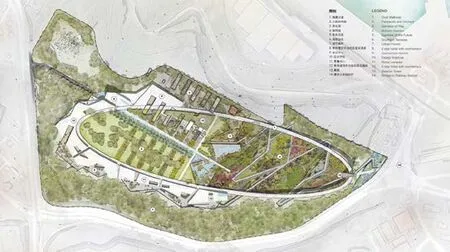
4 总体规划Landscape Character
景观与文化
支撑景观的策略是内外并置的椭圆。内部的椭圆是一个郁郁葱葱、丰富且充满活力的色彩、植物和花园的组合,强烈地反映了现有树群和历史建筑的质朴特征。它还提供了一个多种用户体验的心灵圣地,反映了当代对过去土耳其花园的敬意。外部椭圆景观被改造成一个城市森林,其中包含现有的和新栽植的树木群落,它们雕塑般的树冠彰显了场地的独特景观。
场地分区和活动
多层次和多样性的活动是班德尔玛奇想花园的核心。椭圆环路两侧两家酒店的功能定位均为零售,进一步促进了场地内的活动。活跃的零售台地充分利用了南部的优势,而历史悠久的建筑则被重新诠释为室外露台,用于公共集会、露天用餐和户外活动。设计学院人性化地将历史建筑恢复成动态和多功能的创意空间,并与五星级酒店和会议中心有密切联系。场地分区包括了一系列的活动、设施、展览和节日等文化项目,这些活动激活了历史建筑和整个花园,其中包括一个朝向西北的主要活动空间。
城市形态与结构
受过去山顶村庄的影响,一个大胆、巨型和标志性的城市结构,与公园的历史建筑、植物群落、阻碍区和最大净空高度相呼应。令人难忘的城堡式外观与平滑的椭圆形环路形成鲜明对比,确保了动态多变的用户体验。城市肌理是通过多层次的台地、贯穿场地的通道、中庭庭院和建筑高度变化形成的。城市形态的标志是“灯塔”,这是一个与下方城市沟通的雕塑象征。与“灯塔”互补的是五星级酒店(8层)和四星级酒店(7层),它们的战略定位是视觉上加强场地的重要地位。设计学院是班德尔玛奇想花园的中心部分,充当内外椭圆之间的过渡点。
环境和可持续性
气候适应和环境效应是通过一系列生态措施来实现的,这些措施确保了班德尔玛奇想花园有一个弹性的未来。在外部的椭圆中,采用乡土植物,尊重公园现有的树木群,并保护该遗址不受盛行风和车辆污染的影响。公共空间和台地朝南,以最大限度利用太阳能,同时收集雨水并将其重新用于公园灌溉。建筑采用了交叉通风、屋顶集水和内部日光控制等可持续措施。景墙和花园设施就地采用可循环利用材料,而可食花园则位于果园中。
景观
景观说明
一种现代的、富有想象力的景观呈现,其色彩、肌理、深度和文化都显著分层,以敏感地接纳班德尔玛的遗留景观特征。
班德尔玛奇想花园旨在激发创造性的尝试、富有想象力的思考和知识的共享。在宁静的环境中,它也是一个休息的空间。通过一系列引人入胜的景观、多层次的体验和感官刺激的综合分层,班德尔玛奇想花园从它的历史遗迹中脱颖而出,成为创造性尝试的国际象征。对比鲜明的风景,诸如标志性的“椭圆”“植物园”“果园”和“南部台地”等,每部分都是由一个引人注目的自然的城市森林构成的,这些森林强调了现有常绿矮灌丛形成的场地。
椭圆区
标志性的椭圆构成了班德尔玛奇想花园景观和城市形态的重要组织部分。椭圆形充满力量的外形特质,标志着自充满活力和日常的内部花园到自然而茂盛的城市森林这一景观特征的转变。椭圆从果园开始过渡,上升到地平线,并漂浮于植物园之上,与标志性的“高塔”无缝连接。面向海洋、城市和周围环境的连续全景视野确保了真正独特的游客体验。
公园和果园
公园和果园构成了班德尔玛奇想花园的中央公共空间,其由标志性的椭圆、栅格状的小径、一组草坪和被果园成排围绕的一个经典线性水元素共同构成。这为公园的历史地域特征和雕塑般的针叶树群提供了现代诠释。以茂密的可食树木和具有异国风情的花卉为特征的成排果园,象征着该地区自给自足的农业。在树冠下分散着一系列休息空间,提供座椅、乒乓球、国际象棋以及其他主动或被动的用途。
城市森林
城市森林是一种茂盛、自然而饱经风霜的景观,这种景观尊重公园现有的特征。通过新的针叶树和常绿矮灌丛的种植,现有的树木群落得到强化,形成了班德尔玛奇想花园建筑如自然雕塑般的边缘。额外的种植令树木的树冠更加致密,使山坡水土保持能力增强,同时增加防风能力并降低周围噪声。城市森林中还有一条蜿蜒曲折的步(跑)道。
游乐园
游乐园形成了一种景观的节奏变化,以城市为背景,人们可尽情开展游乐、运动和其他娱乐活动。通过适应性地再利用北部历史建筑用于游赏,游乐园这一灵活的活动空间包含了水、自然和休闲座椅,是班德尔玛奇想花园的娱乐中心。 在围墙、植物园和椭圆步道的范围内,游乐园为各个年龄段的人均提供了充满活力的娱乐体验。
未来花园
未来花园旨在通过多样的空间体验来激发使用者的感官,这些空间体验会对班德尔玛的过去、现在和未来做出回应。花园的中心是修复现有的历史建筑,以容纳一个适应性强且不断变化的装置,或者艺术展览、艺术家的使用和活动等。历史建筑的墙壁围绕着它们邻近的庭院,这些庭院环抱着现有的树木群,并采用适应当地的材料。重要的是,未来花园与设计学院相连,这为创造性的尝试和追求更美好的未来提供了一块画布。
植物园
植物园面朝城市,以展现土耳其自然环境的壮丽。通过丰富多样的特有植物物种、栖息地和生物多样性,花园形成了土耳其独有的天堂式体验。在花园中有各种各样的穿越坡道、观景平台和漂浮的椭圆形结构,展示了土耳其特有的惊奇、喜悦、气味、声音和野生动物。景观中整合了雨水收集措施,水流沿着坡道和茂密的树林汇至湿地和场地的雨水过滤系统。
南部台地
南部台地是花园的延伸。台地由城堡式边缘界定,并适应倾斜的地形,形成朝南的空间来装点城市森林上空的标志性景观。此外,南部台地提供了露天用餐场所、静谧的沉思空间并通过坡道与相邻道路紧密连接。
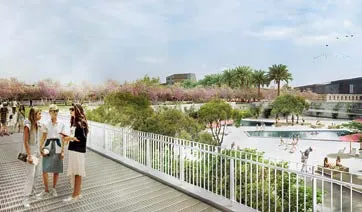
5 景观特征Landscape Character
建筑
建筑说明
一种标志性的建筑形式包含了乡村的历史肌理,创造了一系列空间体验,将地方的独特性与建筑的变革力量交织在一起。
班德尔玛奇想花园采用了一种强大的城市形式,它以一种独特的多面方式回应场地的历史。从通过城堡式的边缘让人联想到过去的山顶村庄,到通过光滑的椭圆墙体立面界定内部空间,班德尔玛奇想花园展示了当代和历史建筑的自信融合,形成了展现创新和想象力的标志性平台。
建筑物内部集成了一系列贯穿场地的巷道、历史形式和中庭,形成微小、可渗透和封闭的空间体验。材料的对比与不同的景观形成协同效应,而像“高塔”等地标性建筑则成为班德尔玛天际线的标志。
设计学院
设计学院独立于椭圆内部,它彰显了现代建筑、历史遗迹、景观空间和创意功能之间的协同作用。通过一个在内外空间之间转换的多样化方案, 设计学院与其历史和景观环境无缝地相交。公共空间可满足室外礼堂座席、图书馆、餐厅、公共庭院和建筑入口的投影空间的需求,以确保一种难忘的空间体验。
设计学院是一个创新的平台,用于实验和创新,以实现更美好的未来。设计、调查研究和分享知识是设计学院进步的核心。
定位
设计学院坐落于椭圆环路的内部,是班德尔玛奇想花园景观中的一个标志。设计学院充分利用其位置优势,可以欣赏马尔马拉海和城市的美景。这是游客从城市到来第一个看到也是最后一个离开的建筑。
建造形式
设计学院对椭圆环路和毗邻的建筑做出了回应,并以柔和的弧线将历史与之并列。 设计学院的建筑体量在垂直和水平方向展开,在班德尔玛奇想花园的建筑语汇中代表了一种独特的反差,标志着设计学院的重要性。
历史建筑
设计学院与场地中的四处历史建筑相连,创造了一种将过去、现在和未来交织在一起的戏剧性体验。残存的历史建筑与更大的建筑体积相结合,产生了私密的庭院和空间,它们支持各种各样的用途、空间体验和创造性的环境。
内部到外部
设计学院意在创建一个开放的建筑,促进所有参观者的知识共享。内部空间和外部空间之间的直接联系营造了建筑形式与景观之间的和谐。建筑的边界消失在景观之中,游客被带入室内,设计被引到室外,十分引人入胜。
材料
设计学院局部采用半透明空间,以展现内部用途,同时在建筑结构内也能体验到外部环境。一个白色的陶瓷格子,让人联想到古代阿拉伯的马什拉比亚(Mashrabiya),它漂浮在建筑物周围,作为一种建筑外表皮。晶格表面为建筑物提供了一个暂时性的大气层,巧妙地运用光、风和阴影来创造一个短暂的空间体验。
用途
设计学院的底层是一个可转换的、具有适应性的空间,可以满足使用者不断变化的需求。 即使设计学院处于关闭期间,底层也会得到最大限度的使用。
通过在建筑物边缘策略性地布置独立的出入口,图书馆、咖啡厅、行政办公室、书店、礼堂和工作坊等关键功能空间对所有人开放。 这种灵活性得到了建筑上层的补充,其目标是创造性尝试、交流和实验的包容性研究。
绿色屋顶
绿色屋顶延伸了景观,面向公园、城市和海洋,提供了令人难以置信的全景。作为一个瞭望点、展览空间、功能室或放松之处,绿色屋顶的多功能性使之对各类环境要素开放。它还为建筑提供隔热,控制设计学院的室内温度。
零售和酒店
零售店和酒店在内部椭圆和城市森林之间形成了一层如膜般可渗透的地带。
它们都通过建筑后退、通透的正立面和底层活动激活底层空间,从而确保一个充满活力的公共领域。
外部的路打破了建筑形式,连接到内部花园和南部台地。

6 局部景观平面图Landscape Partial Site Plan
零售店独特的露台充当垂直和水平分布元素,连接了地下停车场和上层空间。酒店还设置有屋顶露台,客人可以在游泳池、酒吧和休息室欣赏城市美景。
结论
班德尔玛奇想花园象征着一个大胆的新开端,通过景观、建筑、生态和文化历史的当代叠加,展现出一个富有想象力的未来。通过将戏剧性的花园景观、多层次的体验和环境刺激元素分层整合在一起,班德尔玛奇想花园通过创造性的尝试从历史遗迹转变为国际性的象征。它代表了土耳其巴勒克希尔地区的一个充满活力的新方向,战略性地将该城市重新定位为创新中心。
该设计提出了一系列截然不同的景观,以在历史背景下对场地进行重新定位。主要特色包括标志性的椭圆形环路、植物园、游乐园、未来花园、果园和南部台地。每个空间都由一个引人注目的自然城市森林构成,强化了场地中现有常绿矮灌丛的存在。建筑物内部集成了一系列贯穿场地的路径、历史片段和中庭,形成微小、可渗透和封闭的空间体验,而诸如“高塔”和设计学院等标志性建筑则加强了场地的城市外观。
客户:巴勒克希尔市政当局
项目日期:2017
项目地点:土耳其,巴勒克希尔
学科:城市设计、景观设计
面积:26hm2
项目区分:文化与艺术;教育;公共绿地与开放空间;城市中心区
工作范围:棕地规划设计;空间与用地分析;景观规划;开放空间;公共空间策略;公共空间设计;公共空间规划设计;区域再生计划;城市体量研究;城市设计框架;设计竞赛
项目团队:Michael Cowdy; Francesca Visione; Philip Coxall; Tom Rivard; Julia Manrique;Don Do; Ann Deng; Min Kwon; Miguel Serrao
合作者:Vernica; Nura Arquitectes
翻译:孙雪榕
校对:张诗阳
Context
Background
Bandirma Gardens of Imagination is a project that aims to develop a new genre of park cultivating the notion of spatial design and planning as well as creating a recreational destination within Bandirma.
Located in the most dynamic region of Turkey, Bandirma is planned to perform as a major regional gateway for industrial exports through a new port.It is foreseen that this regional transformation will catalyse the regeneration of Bandirma’s city districts.
The project site, in this regard, suggests a strong opportunity to provide a new and alternative open public space within the dense fabric of the city through the future post-industrial transformation of the region.
District
The district of Bandirma is located in the Marmara Region, where the highest general population, the city population and density rates in Turkey can be observed.Being the home of Istanbul, one of the most prominent metropolises of the globe, the region draws attention with the density, production and development rates of Southern Marmara (the area surrounding Bursa and Balikesir) and Eastern Marmara (Kocaeli-Gebze line).
City
Bandırma is a port city located in the south of the Sea of Marmara. The foundation of the city dates back to the 8th and 9th centuries, where as today’s modern city started to take shape on the northwestern hillsides of the city in the 19th century. The industrial progress at the time caused the sprawl across southeast territories along the main road. In the following years, the city has developed westwards, where the project site is also located.
Population
As far as the population progress of Bandirma is concerned, the years 1980 and 2010 were significant turning points. After the Bandirma Port had been put into service, the population increased from 50,000 to 100,000 between 1980—2000; and then continued to rise in the 2000’s fuelled by the developing industrial sector until it reached 150,000. In the last 15 years, the city’s population growth rate is 43% in addition to a rural population of 20,000.
The residents of Bandirma have a high level of education. The literacy rate of the city is 99.5%. 25% of the residents are postgraduates, whereas 30% have graduated from secondary education. The structure of its population and high rate of urbanisation has enabled Bandirma to advance rapidly in the field of education.
These statistics are expected to increase during the realisation of the city’s future planned projects. In addition, the attraction of the city is expected to increase the rural to urban population over the coming years. This why the 2040 environmental plan projects that the population in the city will increase fourfold whilst the rural area will decrease to 16,500 meaning a high rate of urbanisation is expected.
Industry
Located today within the hinterland of Istanbul, Bursa and Izmir,Bandirma is connected to Istanbul and Tekirdag via maritime line and to Balikesir, Izmir, Canakkale and Bursa via a highway. Therefore the regional plans strategically focus on increasing in the accessibility of the city. Taking the transportational connections and perspectives of industrial progress into account, the city is being re-planned due to newly designed connections causing the industrial sector to become more prominent.
From this point of view, Bandirma is up for being one of the important cities supporting the near by metropolises such as Istanbul and Balikesir which are overburdened already. Agricultural industry plays an important role in Bandirma’s economy. Grains in particular, but also tobacco, cotton, sugar beet,olives and grapes, and additionally vegetables are widely grown on the fertile and cultivated lands of the region. Fishing industry and water products are among the main means of living. The industrial sector is dominated by manufacturing.
Evolving into an industrial, touristic and transportational focal point, the region is showing rapid progress and is under the pressure of development;and the new plans are being made accordingly.
Site
Site characteristics
The project site is located within the Yenimahalle and Ayyıldız neighbourhoods, with in the city of Bandırma in the district of Balıkesir.
The project site is located towards the western edge and is around 26 hm2in size. It is within walking distance of the city centre and port and is strategically planed as a large scale, open public place near the centre of Bandırma.
In addition to its close connectivity to the city centre and the port, the west and southwest boundaries of the project site are surrounded by new housing development. It is possible to arrive at the site using the Port Way and the Erdek Way. The site is also 2-3 hours distance by road from the 72 universities located in surrounding cities.
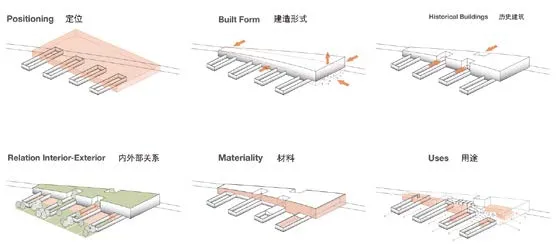
7 建筑特征Building Character

8 设计学院Design Institute
Directly related to the project site, the existing city centre is one of the most important commercial and industrial places of the region. One of the most significant factors for the commercial growth in Bandırma is its busy port and its proximity to close by trade centres.Microclimate
It is located on the Balkanic continental climate transitional area, several climatic features may be observed in the district. According to the data of 62 years, the lowest temperature was measured as -14.6 ºC (January 15, 1954) and the highest as 42.4 ºC (July 9, 2000) in Bandırma. The average temperature is 14 ºC. The predominant wind direction is north-northeast and the average wind speed is 15 km per hour. The average precipitation of the district is 7,033 kg/m, and the annual relative humidity is 73%.
The dominant wind direction is north and north-north east and north-north west. The most frequent wind in the Winter has a speed of 10 km/h,4.8% of the time, whereas the most frequent wind in the Summer month is 15 km/h for 2.6% of the time.
Historical heritage
For forth years the site had been a military storage. In the early 2000’s the site was abandoned,however it was not until the middle of 2016 when the land was handed over to the Municipality.
Currently the project site contains military buildings that are still visible on the site today. In the of ficial statement from Directorate of Natural Heritage Preservation: 21 of these buildings/ruins are listed as “cultural heritage to be preserved” due to their artistic, architectural, historical, aesthetical,local, ornamental, symbolical, documental,functional, financial, commemorative, influential,unique, characteristic, material, constructional and stylistic qualities and registered under 2nd group of preservation. The 2nd group of preservation allows for the alterations that do not reflect on the facade.Landscape
The project site is mainly covered with plants of the phrygana (garrigue) family, coniferous tree groups and scattered bushes. Species of phrygana (garrigue) family, such as thorny burnet(Sarcopoterium spinosum), Iberian knapweed(Centaurea iberica), Spanish broom (Spartium junceum), milkvetch (Astragalus sp.), conehead thyme (Coridothymus capitatus) can be found on slopes and along the northern boundary, a part of the area affected by the sea. In tree groups formed by coniferous species such as cedar of Lebanon(Cedrus libani), Brutian pine (Pinus brutia),stone pine (Pinus pinea), Mediterranean cypress(Cupressus sempervirens); deciduous species such as planes (Platanus sp.), almond (Amygdalus communis), fig (Ficus carica) and mulberry trees(Morus sp.) can be sparsely found, as well.
The project site is characterised by mature coniferous tree groups (tree groups of Cedar, Pine and Cypress), mixed tree groups (deciduous and conifers) and a garrigue formation on the hills of the site. The effect of natural parameters, such as wind creates a distinctive formation seen on the coniferous trees. Together with the historical ruins the site reflects a dramatic landscape character.
With this regard, the project proposals had to develop a sensitive approach to the existing landscape context. The tree groups had to be protected and the project had to clearly reflect protection measures throughout the site.
Strategy
Strategy statement
Taking a holistic and multi-layered approach,Bandirma Gardens of Imagination represents an iconic vision that respects the regions past whilst looking towards an inventive future. Through a unique synergy of experiences, Bandirma Gardens of Imagination symbolises transformative change for Bandirma.
The evolutionary principles that frame the concept are as follows; 1) Integrate: Seamlessly integrate with the sites emerging context. 2)Organise: Organise the site using an iconic form.3) Juxtapose: Juxtapose the contemporary with the old. 4) Define: Define the open space with a built form. 5) Respond: Respond to the sites history with a contemporary bold layer.6) Connect: Connect the site to its context and surroundings. 7) Icon:Create an icon that has a national and international presence.
Access and mobility
Improved connectivity is essential to the success of Bandirma Gardens of Imagination. Major transport oriented initiatives include bus and vehicle access from the west, underground car parking underneath the buildings and a new green bridge that seamlessly connects to the rejuvenated railway station. These initiatives form the foundations to a pedestrian prioritised environment. Central to this environment is interconnected multi-level path system comprising an Oval walkway, linear footpaths, south facing terraces, cascading ramps and an informal perimeter-walking track that links to the adjacent new housing.
Landscape and culture
Underpinning the landscape strategy is a juxtaposition between the inner and outer oval.The inner oval offers a lush, rich and vibrant array of colours, plants and gardens that dramatically expose the rustic character of existing tree groups and historical buildings. It also provides an inner sanctum of multi-user experiences that reflect a modern homage to the Turkish gardens of the past. The outer oval landscape is transformed into an urban forest containing existing and newly planted tree groups that establish a sculptural tree canopy that celebrate the sites unique landscape.
Land use zones and activation
Multi-level activation and diversity are central to Bandirma Gardens of Imagination. The positioning of both hotels at either side of the Oval anchors the retail activities and promotes movement within the site. Active retail terraces takes advantage of the southern aspect, whilst the historic buildings are reinterpreted into outdoor patio’s for public gatherings, al-fresco dining and outdoor functions.The Design Institute sympathetically restores the historical buildings into dynamic and multifunctional creative spaces that have close links to the 5 star hotel and Convention Centre. The land use zoning is overlaid with a cultural program of events,installations, exhibitions and festivals that activate the historical buildings and the gardens as a whole including a major event space towards the north west.
Urban form and structure
A bold, strong and iconic urban structure influenced by hill top villages of the past responds to the parks historical buildings, tree groups,setback zones and maximum clearance heights.
The memorable castellated exterior contrasts with the smooth oval form of the oval ensuring a dynamic and varied user experience. An urban grain is established through multi-level terraces, permeable laneways, atrium courtyards and building height variation. A signature piece of the urban form is the‘Beacon’, a sculptural icon leaning in communication with the city below. Complementing the ‘Beacon’is the 5 Star Hotel (8 storey) and 4 Star Hotel (7 storey) that are strategically positioned to visually reinforce the site’s significant presence. The Design Institute is the centre-piece of Bandirma Gardens of Imagination acting as a transition point between the inner and outer oval character.Environment and sustainability
Climate adaptation and environmental responsiveness are achieved through a series of ecological measures that secure a resilient future for the Bandirma Gardens of Imagination.Endemic planting is embraced within the outer oval respecting the parks existing tree groups as well as protecting the site from prevailing winds and vehicular pollution. Public spaces and terraces are oriented south to maximise solar aspect, whilst rainfall is collected and reused for park irrigation. Buildings adopt sustainable measures through cross ventilation, roof water collection and internal sunlight control. The landscape walls and park furniture embrace onsite-recycled materials, whilst edible planting is located in the Orchards.

9 班德尔玛城市全景View towards Bandirma City
Landscape
Landscape statement
A modern, imaginative landscape emerges,where colour, texture, depth and culture are dramatically layered to sensitively embrace the remnant landscape character of Bandirma.
Bandirma Gardens of Imagination is designed to stimulate creative endeavour, imaginative thinking and knowledge sharing. It’s also a space for respite within a tranquil setting. Through an integrated layering of dramatic landscapes, multi-level experiences and sensory stimulators, Bandirma Gardens of Imagination emerges from its historical remnants as an international symbol for creative endeavour. Contrasting landscapes such as the iconic ‘Oval’, ‘Botanic Garden’, ‘Orchard’and ‘Southern Terraces’ are all framed by a dramatic natural urban forest that strengthens the sites existing Garrigue formation.
The oval
The iconic oval forms the key organisation piece to Bandirma Gardens of Imagination’s landscape and urban form. The Oval’s powerful shape signifies a transformation in landscape character from the vibrant and formal inner gardens to the natural and robust urban forest.Transitioning from the Orchards, the oval ascends the ground plain to float above the Botanical Gardens seamlessly linking with the iconic ‘Beacon’.Uninterrupted panoramic views towards the ocean,city and surrounding context ensure a truly unique user experience.
Parklands and orchard
The Parklands and Orchard form the central public room to Bandirma Gardens of Imagination.Framed by the iconic oval and a grid of paths, a collection of lawns, orchard rows organised around a classic linear water element. This provides a modern interpretation to the park’s historical vernacular and sculptural coniferous tree groups. Characterised by a dense covering of edible trees and exotic flowers the orchard rows symbolise the regions self-sustaining agriculture. Dispersed under the tree canopy are a series of breakout spaces that offer seating, table tennis, chess as well as other active and passive uses.Urban forest
The urban forest is a robust, natural and weathered landscape that honours the park’s existing character. Existing tree groups are strengthened through new Coniferous and Garrigue planting,forming a naturalised sculptural edge to Bandirma Gardens of Imagination’s buildings. The additional planting densifies the tree canopy stabilising the slopes from rainfall, increasing wind protection and buffering surrounding noise. Inserted within the urban forest is a meandering walking/running track.
Gardens of play
The Gardens of Play form a tempo change in the landscape where play, sport and other recreational activities can be enjoyed with the city as a backdrop. Through the adaptively reused northern historical building for play, a flexible collection of active spaces that embrace water,nature and seating for relaxation, the Gardens of Play are Bandirma Gardens of Imagination’s recreational hub. Framed within the confines of a retaining wall, botanical gardens and oval walkway, the Gardens of Play provide an energised recreational experience for all ages.
Gardens of the future
The Gardens of the Future are designed to challenge the users senses through a diverse array of spatial experiences that respond to Bandirma’s past, present and future. Central to the gardens is the restoration of existing historical buildings to house an adaptable and ever-changing array of installations,artist displays, uses and events. The walls of the historical buildings enclose their adjacent courtyards that embrace existing tree groups and adopt a place sensitive materiality. Importantly the Gardens of the Future link to the Design Institute providing a canvas for creative endeavours and pursuit for a better future.Botanic garden
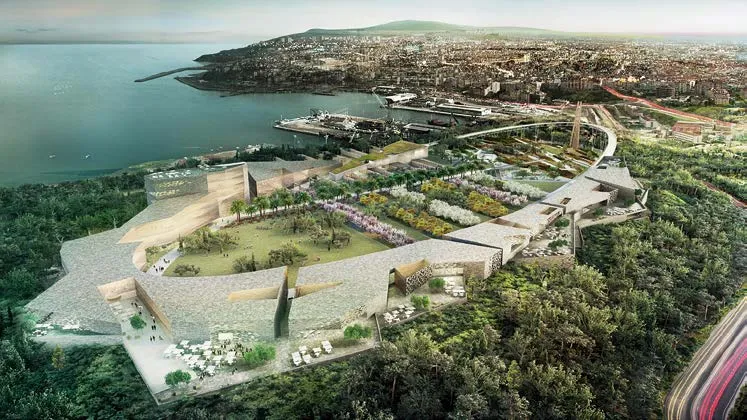
10 班德尔玛奇想花园鸟瞰图Aerial View of Bandirma Gardens of Imagination
The Botanic Garden look towards the city and celebrate the splendour of Turkey’s natural environment. Through a rich and varied collection of endemic plant species, habitats and biodiversity the gardens form a paradise experience unique to Turkey. Nestled within the gardens are a variety of traversing ramps, viewing platforms and the floating oval structure that reveal the surprise,delight, smells, sounds and wildlife of Turkey.
Integrated within the landscape are stormwater collection initiatives that cascade alongside the ramps and dense foliage to a wetland and site water filtration system.
Southern terraces
The southern terraces are an extension to the gardens. Defined by a castellated edge, the terraces adapt to the sloping terrain creating south facing spaces that celebrate the iconic vista’s above the urban forest. In addition the southern terraces offer alfresco dining, quiet contemplative spaces for reflection and accessible ramps that link seamlessly adjacent paths.
Buildings
Buildings statement
An iconic building form embraces the rustic historical grain, creating a collage of spatial experiences that interweave the uniqueness of place with the transformative power of architecture.
Bandirma Gardens of Imagination embraces a powerful urban form that responds to the sites history in a unique multi-faceted manner. Through the castellated edges reminiscent of the hill top villages of the past to the smooth ovoid facade framing the internal spaces. Bandirma Gardens of Imagination demonstrates a con fident merging of contemporary and historical architecture promoting an iconic platform for innovation and imagination.
Integrated within the buildings are a series of laneway intrusions, historical extrusions and atrium patio's that promote a fine grain, permeable and enclosed spatial experience. Contrasting materiality form a synergy with the differing landscapes, whilst landmark buildings such as the ‘Beacon’ tower become icons in the Bandirma skyline.
Design Institute
Uniquely positioned within the inner sanctum of the oval, the Design Institute demonstrates a synergy between modern architecture, historical remnants,landscape spatiality and creative functionality.Through a diverse program that transitions between internal and external spaces, the Design Institute seamlessly intersects within its historical and landscape setting. Public spaces cater for outdoor auditorium seating, a library and café space, a public courtyard and a projection space at the building entry ensuring a memorable spatial experience.
The Design Institute is a creative platform for experimentation and innovation to achieve a better future. Design, investigation and sharing knowledge are central to the evolutionary development of the Design Institute.Positioning
The Design Institute sits in the inner part of the oval path, as an icon in Bandirma Gardens of Imagination’s landscape. The Design Institute takes advantage of its position, with views over the Marmara Sea and the city. It is the first building to see when the visitor arrives from the city and the last to leave behind.Built form
The Design Institute responds to the Oval walkway and adjacent buildings with a gentle arc that juxtaposes the historical grid. Expanding vertically and horizontally, the building volume represents a unique deviation in the Bandirma Gardens of Imagination’s architectural language signifying the Design Institutes importance.
Historical buildings
The Design Institute intersects with four of the site’s historical buildings, creating a dramatic experience that interweaves the past, present and future together.The remnant historical buildings engage with the larger architectural volume generating intimate courtyards and voids that support a diverse array of uses, spatial experiences and creative environments.
Interior to exterior
The idea of the Design Institute is to create an open building that promotes knowledge sharing for all visitors. The direct link between the interior and exterior spaces creates a harmony between the built form and landscape. The boundaries of the building disappear in the landscape bringing visitors inside and the design outside, merging and engaging people.
Materiality
The Design Institute adopts a semi transparent volume that partially expresses the internal uses allowing the external environment to be experienced within the architecture. A white ceramic lattice reminiscent of the ancient Arabic Mashrabiya floats around the building as an external skin.
The lattice facade provides a temporal atmospheric layer to the building, manipulating light, wind and shadow to create a transient spatial experience.Uses
The ground floor of the Design Institute is a transient, adaptable space that responds to the changing needs of its users. The ground floor uses are con figured in a manner that results in maximum usability even if the Design Institute is closed.
Through independent access points strategically placed along the buildings edge, key uses such as the library, cafe, administrative office, book shop,auditoriums and fabrication workshop are open to all.This flexibility is complemented by the upper floor uses that target inclusive study for creative exploration,discourse and experimentation.
Green roof
A green roof forms a visible and physical extension to the landscape, offering incredible panoramic views towards the park, the city and the sea. The green roof provides a multifunctional carpet that acts as a lookout point, exhibition space, function room or place for relaxation open to the environmental elements. It also provides thermal insulation to the roof,controlling the inner temperature of the Institute.
Retail & Hotel
The retail and hotel form a permeable membrane between inner oval and the urban forest.
They both promote ground floor activation through setbacks, transparent frontage and ground floor activation ensuring a vibrant public domain.
External laneways break the built form, linking the internal gardens to the southern terraces.
The retails unique patio’s act as vertical and horizontal distribution elements promoting easy access between the underground car park and upper level spaces. Whilst the hotel supports a rooftop terrace where views towards the city can be enjoyed from a swimming pool, bar and lounge seating.
Conclusion
Bandirma Gardens of Imagination symbolises a bold new beginning, where an imaginative future is revealed through a contemporary synergy of landscape, architecture, ecologies and cultural history. Through an integrated layering of dramatic garden landscapes, multi-level experiences and environmental stimulators, the Bandirma Gardens of Imagination emerge from their historical remnants as an international symbol for creative endeavour. The Bandirma Hayal Bahçeler represents a dynamic new direction for Turkey’s Balikesir region, strategically repositioning the city as a centre for innovation.
The design proposes a series of contrasting landscapes that repurpose the site within its historical setting. Key features include an iconic Oval, a Botanic Garden, Gardens of Play, Gardens of the Future,Orchards and a Southern Terrace. Each space is framed by a dramatic natural urban forest that strengthens the sites existing Garrigue formation.
Integrated within the buildings are a series of laneway intrusions, historical extrusions and atrium patio’s that promote a fine grain, permeable and enclosed spatial experience whilst landmark buildings such as the ‘Beacon’ tower and Design Institute strengthen the sites city presence.
Client:Balikesir Metropolitan Municipality
Project Date:2017
Project Location:Balikesir, Turkey
Discipline:Urban Planning; Landscape Design
Total Site Area:26hm2
Sector :Culture and Art; Education; Public Green Space and Open Space; Urban Center
Scope :Brownfield Planning and Design; Spatial and Land Use Analysis; Open Space; Public Space Strategy; Public Space Design; Public Space Planning and Design; Regional Regeneration Plan; Urban Mass Research; Urban Design Framework; Design Competition
Project Team :Michael Cowdy; Francesca Visione; Philip Coxall; Tom Rivard; Julia Manrique; Don Do; Ann Deng; Min Kwon; Miguel Serrao
Collaborators :Vernica; Nura Arquitectes
Translator:SUN Xuerong
Proofreader:ZHANG Shiyang
(Editor / ZU Xiaoyan)
(编辑/祖笑艳)

